The end of 90 years of TV history as the last analogue transmitters go dark
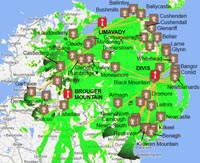
After today, analogue TV in the UK is no more.
The last transmitters to be switched off, just after midnight tonight, will be the Brougher Mountain, Divis and Limavady masts in Northern Ireland, along with over 40 smaller local relays.
647,500 homes will finally lose their analogue TV, and the UK digital switchover will be 100% complete.
Not only does this bring to an end a history of analogue TV going right back to early test-transmissions by the rival Baird and Marconi-EMI systems back in the 1920s, it also signals the end of PAL TV, Ceefax text services and Nicam stereo sound – from here on in the TV chain is digital from start to finish.
Of course, the TV system just about to breathe its last is a long way from those early broadcasts: in the intervening years we've gone from Baird's first electromechanical system, using ever-larger scanning discs with near-lethal capabilities, to the current HD format; from short-wave to VHF to UHF; from five lines to 40 to 240, on to 405 then 625 and 1080i; from five frames a second to 50 or 60. and from fuzzy black and white to crisp colour and even 3D.
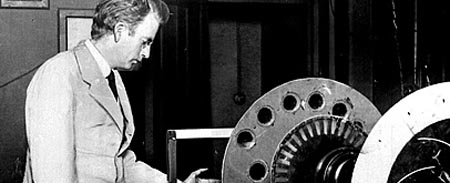
Back at the dawn of TV, John Logie Baird (above) had been experimenting with electromechanical scanning TV, using ever larger scanning discs spinning at increasing speeds to improve sensitivity and definition.
That almost proved his undoing when a massive disc, over 8ft in diameter with eight-inch lenses and running at 750rpm, came apart in his lab: the lenses flew off, shattering as they hit the walls, and the now-unbalanced disc careered around the room before wrecking itself.
Get the What Hi-Fi? Newsletter
The latest hi-fi, home cinema and tech news, reviews, buying advice and deals, direct to your inbox.
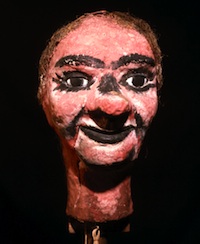
As if that wasn't terrifyng enough, Baird's early tests were carried out using subjects including this frankly rather scary-looking ventriloquist's dummy head, simply because the bright lights required by the system were just too hot for any human subject to withstand. Known as 'Stookie Bill', the dummy is now in the collection of the National Media Museum, Bradford.
By early 1925 Baird was able to give public demonstrations of the technology in Selfridges department store in London's Oxford Street, using just five lines to create 'shadowgraphs' – silhouettes of what was being shot – and leading Baird to realise at least 30 lines would be needed to create shades of grey and thus recognisable images.
He achieved this in October 1925, and just three months later was able to give the world's first demonstrations of television.
Within three years he had also developed the beginnings of colour TV, 3D TV, infrared TV and even a TV recording system, which he called Phonovison, storing TV pictures on discs (below, also in the NMM collection).
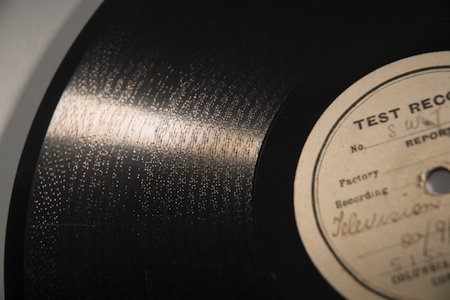
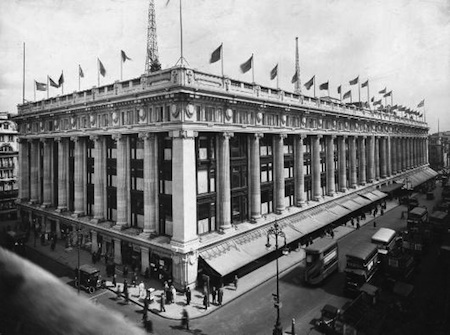
He'd also managed to transmit live pictures from London to New York, and by 1929 was using his own studio in London's Covent Garden and the BBC's 2LO transmitter, on the roof of Selfridges – you can just about see it in the picture above – , to transmit television pictures.
Overnight TV – first vision, then sound
Originally the service ran during the closedown period of the radio transmissions from 2LO, which ended around 11pm and didn't start up again until mid-morning – no late-night radio or Today programmes in those days.
Since there was just the one transmitter, the broadcasts ran as two minutes of pictures, then two minutes of sound, but by early 1930 the BBC had two transmitters, so sound and vision could be sent together, and in June the first TV play was transmitted, using a fixed camera in front of which the different characters appeared.
The BBC took over the transmissions in 1932, using a TV studio in the basement of Broadcasting House, and watched by a few thousand buyers of early Baird 'Televisors', sales of which funded the Baird transmissions.
The service shut down in 1935, and was replaced in 1936 by the BBC's 'high definition' service.
The inevitable format war
But there was a rival system – isn't there always a format war? – developed by a team at EMI in Hayes, west London. They'd come up with a version of the Icomoscope electronic camera tube invented by Russian exile Valdimir Zworykin at RCA in the States – he'd also come up with the Kinescope receiver tube – and this EMI Emitron technology became the mainstay of BBC TV cameras for over 20 years.
The leader of the EMI team, Isaac Shoenberg, was sanguine about what they were working on: after the first demonstration of the electronic system in 1934, he said to his engineers ''Well. gentlemen, you have now invented the biggest time waster of all time. Use it well.'
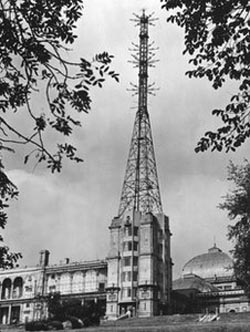
Going into the mid-1930s, the two TV systems – Baird's 40-line electromechanical system and the infant EMI electronic one – were both proposed for tests at the BBC's London station.
The Government wanted 'High Definition television' – well, it has a certain ring to it! –, and while Baird strove to increase the definition of his system to 240 lines, and his company started building its transmitters, the team at EMI went for broke and aimed for 405 lines, also bringing in radio pioneer Marconi to design its transmission system.
The Government plan was to run a six-month trial, the two systems broadcasting for alternate weeks, and the BBC rented part of Alexandra Palace, located high on a hill overlooking London from the North and formerly a Victorian entertainment centre, as the base for the trials.
After all, the logic went, the antenna needed to be 600ft up to give decent coverage (around 25 miles radius), so it made sense to find a location already 300ft up, thus halving the size of the mast needing to be built.
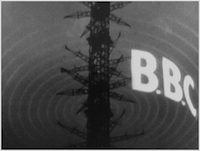
For the trivia fans, the Alexandra Palace mast was up and running in just over a year, and went on to become a BBC icon, appearing at the beginning of news broadcasts – or newsreels as they were called in those days, taking their name from the short news programmes then common in the cinema as part of the support for the main feature.
Oh, and for the deep trivia fans, the Ally Pally mast was where Dr Who villain The Wire (played by Maureen Lipman, seen below amidst period BBC testcards) – an alien invading viewers' minds through their TV sets in the run-up to the 1953 Coronation – met her end in the 2006 episode The Idiot's Lantern.
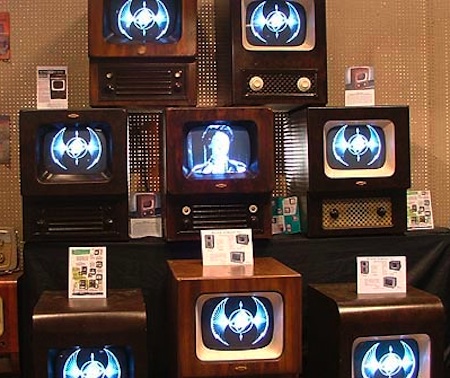
More on the importance of the Coronation in the TV story to come – but now, back to the history...
The plan was to start the trial in November 1936, but pressure from radio manufacturers planning to exhibit TV sets at the 1936 Olympia Radio Show in August that year meant demonstration programmes were required pronto.
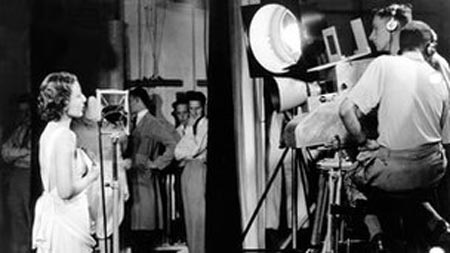
Thus with the 300ft mast and 34kW transmitter installed at Ally Pally, a hastily thrown-together variety show called Here's Looking At You (above) was ready for two weeks of twice-daily broadcasts.
The two rival companies broadcast on alternate days, and each had its own studio and control room, and the TV service started for real on November 2nd, 1936 with an opening ceremony broadcast twice – once on each system. You see, the idea of repeats started early on the BBC!
You can see a Movietone news film of the first transmission – shot during the second 'take' using the Marconi-EMI system and multiple cameras – below. (The time-code is a later addition!)
From the start, the BBC engineers were pretty clear the Marconi-EMI system was the one to have, pioneering TV producer Cecil Madden – who'd put together that first show – saying of the rival Baird system 'It was like playing with clockwork when we'd already got electricity. The bloody thing just wouldn't work'.
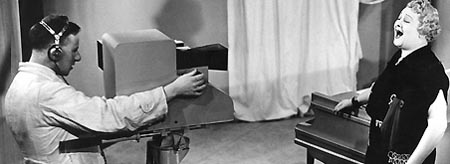
You can see why: in Studio A, the Marconi-EMI system (above) had three cameras, able to be moved around on dollies between shots; in Studio B the Baird system (below) was much more limited, with a fixed camera, and an announcements system shooting film which was run through a tank of cyanide processor(!) then scanned and broadcast with a delay of just under a minute.
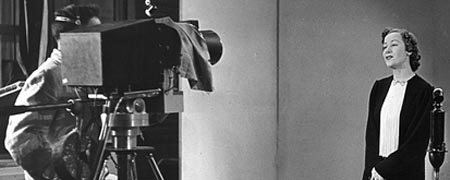
By the end of January 1937 the Baird system was ditched and – apart from a break during World War II – the 405-line service would run on the BBC until it was finally turned off in 1985, 16 years after the first 625-line UHF services had started in the UK.
When the service shut down for the war, on September 1st 1939, there were only around 20,000 sets in use, all in London and the surrounding counties, but as early as 1943, with TV still dark, a Government committee was planning the resumption of services.
Published in 1945, and inspired by the arrival of the higher-definition NTSC system in the USA, offering 525 lines in place of the UK's 405, their report called for a 1000-line service, hoped for colour and stereoscopic effects, and required wider geographical availability.
The last one was almost as tricky as the first two, and among the bonkers ideas suggested to give better coverage was a mile-high single transmitter mast in North London, a transmitter held up by a huge hydrogen balloon, and a US idea called stratovision, with a constantly circling aircraft carrying the aerial.
In the end, although EMI would come up with a prototype 1001-line TV system some three years later, it was decided to stick with 405 lines, add extra transmitters to spread the service – the second one was at Sutton Coldfield in 1949 – , and relaunch the service on June 7th, 1946.
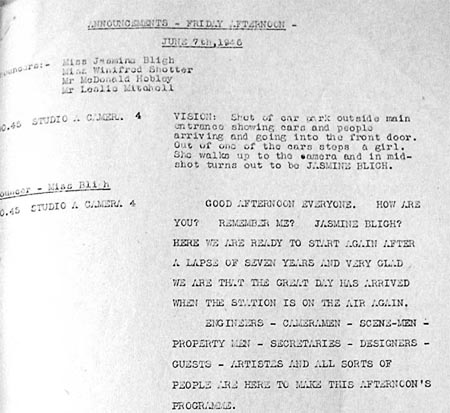
And viewers got a 50% increase in broadcast time – there were now three hours a day!
By 1952 a significant proportion of the population were in the TV reception area, the number of TV licences had risen from 126,000 in 1949 to over three quarters of a million in 1951, and the country's first big TV event took place the following year: the Coronation of Queen Elizabeth II was watched by almost 20m people.
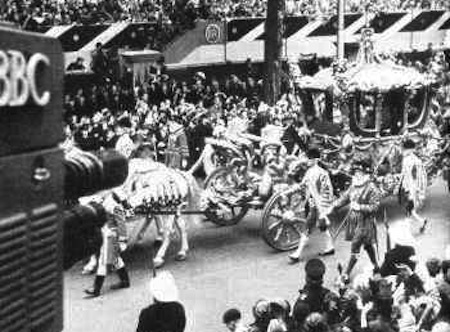
Almost 8m watched at home, over 10m watched in someone else's home, and 1.5m watched public showings.
TV was becoming a part of our lives, and by 1954 there were 3.2m licences held, ITV was on the way, and the BBC was planning to move from its base in the converted film studios in Shepherd's Bush to a purpose-built Television Centre (below) just up the road.
First announced in 1949, the building was to be the largest TV production facility in the world, built on a 13-acre derelict site once part of the Franco-British Exhibition and the subsequent 1908 London Olympics.
Colour, stereo sound and Ceefax – the text service destined to become the precursor of the mass of information we now have on the internet – were yet to come.
And when Ceefax happened, What Hi-Fi? played its part: our unofficial historian reports that, back in the 1970s, the magazine's 'Computerised Buying Guide' – as it was trumpeted on the cover of every issue back then – was available on Ceefax.
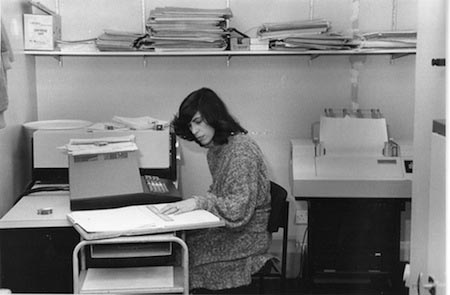
Run on Haymarket's first-ever computer (seen above being operated by the unofficial historian) and launched at one of those famous Harrogate hi-fi shows, it was uploaded on the then-new service for instant reference.
Now there's an idea that might just catch on...
Andrew has written about audio and video products for the past 20+ years, and been a consumer journalist for more than 30 years, starting his career on camera magazines. Andrew has contributed to titles including What Hi-Fi?, Gramophone, Jazzwise and Hi-Fi Critic, Hi-Fi News & Record Review and Hi-Fi Choice. I’ve also written for a number of non-specialist and overseas magazines.
